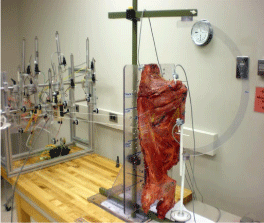Editorial
Research Interest and Projects
Bassem Elhassan*
Department of Pediatric Cancer, Mayo Clinics, USA
*Corresponding author: Bassem Elhassan, Department of Pediatric Cancer, Mayo Clinics, USA
Published: 25 Nov, 2016
Cite this article as: Elhassan B. Research Interest and
Projects. Clin Oncol. 2016; 1: 1144.
Editorial
Managing complex shoulder disorders as result of brachial plexus injury (obstetric or adult),
or significant bone or soft tissue deficiency secondary to injury, advanced degenerative changes
or tumor resection could be very challenging. Our work in the lab focuses on evaluating the
biomechanics of different types of bony and soft tissue reconstruction to attempt to restore shoulder
function in these types of complex shoulder cases.
We have developed over the years several novel tendon transfers in attempt to restore the
scapulothoracic and glenohumeral joint motions. In order for the biomechanics to be more accurate,
we created a novel state of the art shoulder model that is based on a full hemibody with all muscles
and joints remain attached. The hemibody is fixed to a board with multiple holes in it that allow
the passage of the numerous cords coming from different muscles of the shoulder area. The cords
are created in a way to attempt to replicate the line of pull of the muscles that need to be evaluated
around the shoulder. These cords are passed through pulleys and pistons to attempt to mimic
normal shoulder muscles function and biomechanics. Joint pressure analysis is also performed.
In patients with trapezius deficiency secondary to nerve injury or muscle injury or muscle
resection could lead to significant derangement of the shoulder function secondary to destabilization
of the scapulothoracic function. The most commonly described procedures in the literature to
manage this problem include the Eden-Lange procedure and scapulothoracic fusion. We leave
the scapulothoracic fusion as last resort as salvage procedure. As for Eden-Lange we did evaluate
the biomechanics and found it to not replicate the normal scapulothoracic function. This is also
reflected by the inconsistent clinical outcome studies reported in the literature. We did come out
with a novel transfer we called it the triple transfer that entails independent transfers of the levator
scapula, rhomboid minor and rhomboid major to the spine of the scapula to replicate the function
of the trapezius. The biomechanics replicate those of normal trapezius and our clinical outcome
study did prove it.
For patients with massive posterior-superior rotator cuff, the most commonly described
procedure is the latissimus transfer. The outcome also has been variable especially for patients with
pseudoparalysis of the shoulder. We came up with a novel transfer, the lower trapezius transfer that
also we were able to determine that it is biomechanically better than latissimus transfer. We were
able to prove the validity of this transfer clinically as well.
For patients with irreparable subscapularis tear or anteriorsuperior
rotator cuff tear, the most commonly described procedure is
the pectoralis transfer. However, the results have been disappointing
especially if the shoulder is anteriorly subluxated. So we came up
with a novel transfer, which is the latissimus transfer anteriorly to the
anterior-proximal aspect of the shoulder. Biomechanical comparison
between the latissimus transfer and pectoralis transfer showed that
the latissimus transfer was significantly better in replicating the
biomechanics of the subscapularis tear. Clinical study is on its way
but the preliminary studies are very promising.
For patients with obstetric brachial plexus injury, especially for
those who present when don’t present in the first 5 years, the main
procedure described for them to improve their shoulder external
rotation is osteotomy of the humerus. Unfortunately, this procedure
does not correct any of the significant bony deformities of the
shoulder. So, we described a novel procedure that entails corrective
osteotomy of the acromion, reconstruction of the glenoid, releasing
the contracture of the shoulder and lower trapezius transfer. When
we evaluated the new construct biomechanically, it did replicas very
closely the shoulder anatomy and mechanics.
In summary, our research studies are focused on the biomechanical
evaluation of different types of novel shoulder reconstruction and
determine the feasibility of different types of tendon transfers (Figure
1). We also in the process of publishing our clinical outcome studies
using different novel types of shoulder reconstructions.

